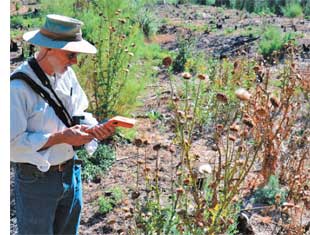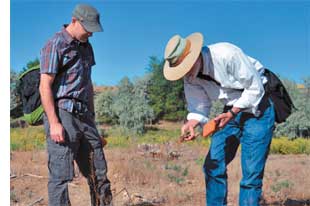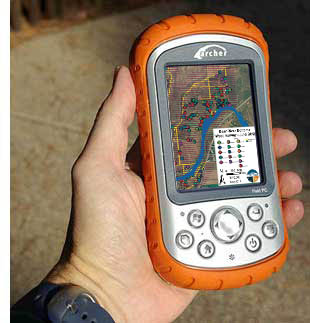Surveying land and capturing pertinent data is complex, time-consuming work. Even under the best of circumstances, operational and transcription errors, equipment failures and loss of data can delay or even jeopardize the best-planned project. This article, based on a customer story, describes how ultra-rugged Archer Field PCs, supplied by Juniper Systems of Logan, Utah, helped in the mapping of riparian areas in the Bear River area of the Great Basin.

The Great Basin encompasses nearly all of Nevada, as well as more than half of Utah and substantial parts of every other adjacent state. It is a land of basins and ranges. Large cities lie along its rim, but the center consists of seemingly empty open spaces. Most of the sparsely distributed communities are small, evolved from ranching or mining activities over the last 150 years.
 Apart from a few mountain ranges that receive abundant snowfall, annual precipitation in most of the Great Basin is less than 20 inches, with vast desert areas receiving less than eight inches. Since water sustains life and the richest and most diverse habitats occur near water, protecting riparian areas — the wetlands adjacent to rivers and streams — warrants high priority in conservation efforts.
Apart from a few mountain ranges that receive abundant snowfall, annual precipitation in most of the Great Basin is less than 20 inches, with vast desert areas receiving less than eight inches. Since water sustains life and the richest and most diverse habitats occur near water, protecting riparian areas — the wetlands adjacent to rivers and streams — warrants high priority in conservation efforts.
In Utah, riparian areas amount to less than 0.25% of the land. Most rivers never reach the sea, instead terminating in the Great Salt Lake, itself a unique and valuable habitat for birds and other species. The largest river emptying into the Great Salt Lake is the 500 mile Bear River, originating in the Uinta Mountains of northeast Utah and flowing through Wyoming and Idaho before reentering Utah. Protecting the riparian habitat along this river has long been a major project for conservation groups such as the Bear River Land Conservancy (BRLC), the Utah Division of Forestry, Fire, and State Lands (DFFSL), and the Utah Conservation Corps (UCC) that is part of the AmeriCorps program at Utah State University.
Riparian area survey efforts are complicated by the fact that over 90% of the river's length is privately owned and may or may not be accessible. Nevertheless, a data collection project was conducted in 2012 with the goal to assess the extent of weed infestations and develop a plan for controlling noxious and invasive weeds that can significantly alter soil composition and water availability for native plants that are an important food source for animals and are necessary for a healthy riparian habitat.  This included establishing transects spaced 20 meters apart, and walking the land to record the most serious weed species, the size of the patch, percent coverage, hydrological conditions, and phenology.
This included establishing transects spaced 20 meters apart, and walking the land to record the most serious weed species, the size of the patch, percent coverage, hydrological conditions, and phenology.
The Juniper Systems Archer Field PC was chosen to collect the data because of its ruggedness, ease of use, and flexibility. Each Archer was equipped with GPS and ESRI ArcPad software. ArcPad forms were developed to eliminate data entry errors and make quality control easier. UCC personnel were split into two crews of two persons each and spent three weeks walking the property, accessing riparian lands by foot or by boat.
Every night, the crew leader would retrieve the data from each Archer and merge it into a growing database of weed locations. Before going out the next day, each Archer was then loaded with the merged data so crews would know the areas that were mapped the day before. By the end of the period, UCC recorded 3,000 patches of weeds of 16 species.
One of the objectives of the 2012 project was to follow up on a similar data collection effort conducted in 2006, which also used Archer Field PCs. This would give BRLC the data to not only plan for resources to control new weed patches, but also made possible an evaluation of the success of recent treatment efforts.
Why did BRLC choose the Archer Field PC? The organization's volunteer Executive Director, Bryan Dixon, has used Archer Field PCs for five years with dozens of new field crew members in many situations. "I've relied on Archer Field PCs in my environmental consulting firm (Cirrus Ecological Solutions, LC) to collect data on mountains, along rivers, and in helicopters and never lost a single data point. These devices are rugged, can run all day on a single battery, and in only a few hours I can train crews to collect complex data independently and self-sufficiently," Dixon said. "When we needed equipment to map weeds along miles of the Bear River with UCC crews that had never used this kind of field equipment before, relying on Archers was a no-brainer."
Dixon's comments touch upon a number of key requirements that rugged field computing equipment must meet in order to be a useful, productivity-enhancing asset rather than a potential source of frustration:

- The equipment must be truly, inherently rugged, and not just ruggedized or protected by an aftermarket case. Truly rugged devices are designed from the ground up to survive drops, vibration and tumbles, as well as being completely dust- and waterproof.
- Absolute reliability is a must. Data collection in the field is hard work and re-doing it due to glitches or failures is often cost-prohibitive or downright impossible. This means mature hardware and software, and a track record of reliability.
- On field assignments, battery life must be measured in shifts or days, and not just in hours. Away from electrical outlets and not always able to replace batteries, field personnel must be able to rely on adequate battery power at all time.
- Field computing equipment can greatly enhance productivity, but only if it is user-friendly enough for crew members to be comfortable operating it. Suitable field computing equipment must be easy to learn and master, without extensive training requirements.
- Outdoor lighting conditions vary from direct sunlight to near darkness, mandating displays that are easy to view and read under a wide variety of lighting intensity. Displays also must be able to control glare and reflections.
 The Archer Field PC by Juniper Systems fills the above listed requirements. It is a very sturdy, ultra-rugged handheld computer. Don't let the friendly orange protective cladding fool you — the core of the Archer is a rock-solid, brilliantly engineered magnesium case that seems milled from a solid block of metal. Its electronics are based on ultra-mature Pocket PC technology and the OS software (Windows Mobile 6.1 Classic) is equally mature from many years of field-testing and experience.
The Archer Field PC by Juniper Systems fills the above listed requirements. It is a very sturdy, ultra-rugged handheld computer. Don't let the friendly orange protective cladding fool you — the core of the Archer is a rock-solid, brilliantly engineered magnesium case that seems milled from a solid block of metal. Its electronics are based on ultra-mature Pocket PC technology and the OS software (Windows Mobile 6.1 Classic) is equally mature from many years of field-testing and experience.
The 3.5-inch QVGA display is not large or high-res by today's smartphone standards, but it gets the job done and it is very power-efficient. Combined with a generous 14 watt-hour battery, the Archer can run as long as 20 hours on a single charge. The Archer Field PC shown in the picture to the right is running ESRI ArcPad software, used by the Bear River survey team.
Note that the Archer model shown in the application pictures above has an angled integrated extension. The extension contains a specially configured Hemisphere GPS XF101 that adds very high DGPS accuracy to the Archer handheld computer, making it suitable for field data collection and other GPS/GIS applications that require accurate geospatial information.
Relevant Information:
— Bear River Land Conservancy Customer Story
— Juniper Systems Archer Field PC page
— Juniper Systems Archer XF101 Rugged Handheld page
— Bear River Land Conservancy
— Utah Division of Forestry, Fire, and State Lands (DFFSL)
— Utah Conservation Corps (UCC)
To learn more about the ultra-rugged Juniper Systems Archer Field PC and its many applications, email Juniper Systems at info at junipersys.com. And check RuggedPCReview.com's full review of the Archer Field PC, the XF101 version, as well as our video review that shows the interior construction of the Archer Field PC.






